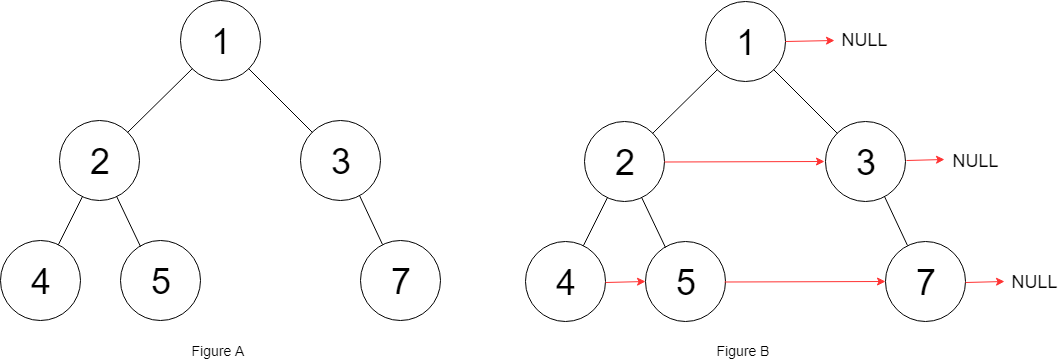LeetCode 솔루션 분류
[5/13] 117. Populating Next Right Pointers in Each Node II
본문
[LeetCode 시즌 3] 2022년 5월 13일 문제입니다.
https://leetcode.com/problems/populating-next-right-pointers-in-each-node-ii/
117. Populating Next Right Pointers in Each Node II
Medium
3671237Add to ListShareGiven a binary tree
struct Node {
int val;
Node *left;
Node *right;
Node *next;
}
Populate each next pointer to point to its next right node. If there is no next right node, the next pointer should be set to NULL.
Initially, all next pointers are set to NULL.
Example 1:

Input: root = [1,2,3,4,5,null,7] Output: [1,#,2,3,#,4,5,7,#] Explanation: Given the above binary tree (Figure A), your function should populate each next pointer to point to its next right node, just like in Figure B. The serialized output is in level order as connected by the next pointers, with '#' signifying the end of each level.
Example 2:
Input: root = [] Output: []
Constraints:
- The number of nodes in the tree is in the range
[0, 6000]. -100 <= Node.val <= 100
Follow-up:
- You may only use constant extra space.
- The recursive approach is fine. You may assume implicit stack space does not count as extra space for this problem.
관련자료
-
링크
댓글 5
mingki님의 댓글
- 익명
- 작성일
C++
Runtime: 15 ms, faster than 73.10% of C++ online submissions for Populating Next Right Pointers in Each Node II.
Memory Usage: 17.6 MB, less than 44.54% of C++ online submissions for Populating Next Right Pointers in Each Node II.
Runtime: 15 ms, faster than 73.10% of C++ online submissions for Populating Next Right Pointers in Each Node II.
Memory Usage: 17.6 MB, less than 44.54% of C++ online submissions for Populating Next Right Pointers in Each Node II.
class Solution {
public:
Node* connect(Node* root) {
queue<Node*> q;
if (!root) return root;
q.push(root);
while (!q.empty()) {
int size = q.size();
for (int i = 0; i < size; ++i) {
Node *tmp = q.front(); q.pop();
tmp->next = i == size - 1 ? NULL : q.front();
if (tmp->left) q.push(tmp->left);
if (tmp->right) q.push(tmp->right);
}
}
return root;
}
};austin님의 댓글
- 익명
- 작성일
class Solution {
public:
Node* connect(Node* root) {
for(vector<Node*> cur{root}, tmp; root && !cur.empty(); cur = move(tmp)) {
Node* prev = nullptr;
for(auto n : cur) {
if (prev) prev->next = n;
if (n->left) tmp.emplace_back(n->left);
if (n->right) tmp.emplace_back(n->right);
prev = n;
}
}
return root;
}
};bohuim님의 댓글
- 익명
- 작성일
class Solution {
var map = [Node?]()
func connect(_ root: Node?) -> Node? {
guard let node = root else { return nil }
return connect(node, depth: 0)
}
func connect(_ node: Node, depth: Int) -> Node {
// If we haven't seen this depth yet, append a nil.
let nextDepth = depth + 1
if map.count < nextDepth {
map.append(nil)
}
// Do a reverse order traversal.
if let right = node.right {
connect(right, depth: nextDepth)
}
node.next = map[depth]
map[depth] = node
if let left = node.left {
connect(left, depth: nextDepth)
}
return node
}
}Coffee님의 댓글
- 익명
- 작성일
/*
// Definition for a Node.
class Node {
public int val;
public Node left;
public Node right;
public Node next;
public Node() {}
public Node(int _val) {
val = _val;
}
public Node(int _val, Node _left, Node _right, Node _next) {
val = _val;
left = _left;
right = _right;
next = _next;
}
};
*/
class Solution {
public Node connect(Node root) {
if(root == null){return root;}
Queue<Node> queue = new LinkedList<Node>();
queue.add(root);
while(queue.size() > 0){
int size = queue.size(); // size is level
for(int i=0; i<size; i++){
Node node = queue.poll(); // check
if(i < size - 1){ // connect the nodes at current levels.
node.next = queue.peek();
}
// add children
if(node.left != null){
queue.offer(node.left);
}
if(node.right != null){
queue.offer(node.right);
}
}
}
return root;
}
}나무토끼님의 댓글
- 익명
- 작성일
Runtime: 82 ms, faster than 26.79% of Python3 online submissions for Populating Next Right Pointers in Each Node II.
Memory Usage: 15.3 MB, less than 48.78% of Python3 online submissions for Populating Next Right Pointers in Each Node II.
Memory Usage: 15.3 MB, less than 48.78% of Python3 online submissions for Populating Next Right Pointers in Each Node II.
class Solution:
def connect(self, root: 'Node') -> 'Node':
if not root:
return root
que = []
que.append(root)
while que:
size = len(que)
for i in range(1, size):
que[i - 1].next = que[i]
for i in range(size):
front = que.pop(0)
if front.left:
que.append(front.left)
if front.right:
que.append(front.right)
return root









